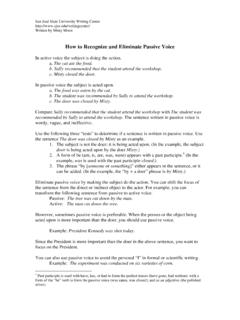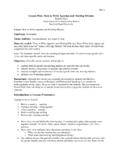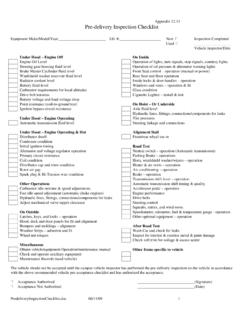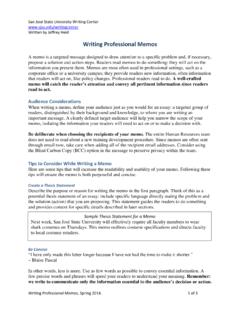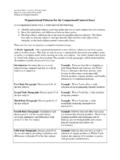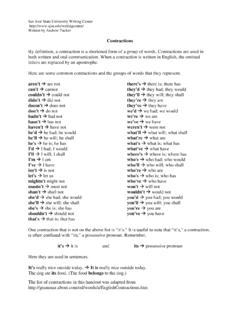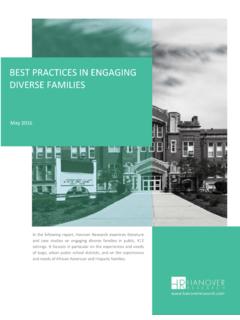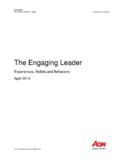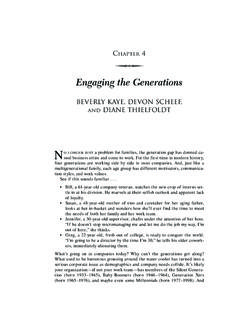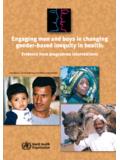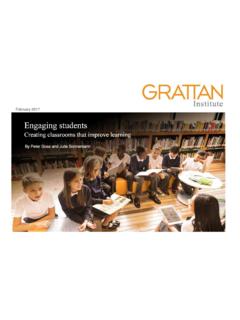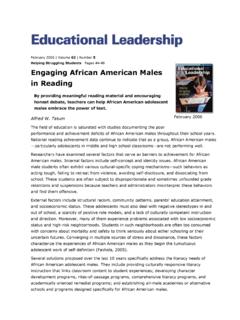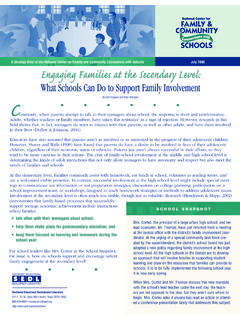Transcription of Introduction: Faculty Toolkit for Engaging Campus …
1 Introduction: Faculty Toolkit for Engaging Campus Diversity Welcome to the Faculty Toolkit ! This Toolkit has been designed for the use of all First Year Experience (FYE) course coordinators and instructors (MUSE, Science 2, Humanities Honors, ENG) in order to support the Inclusive Excellence student learning outcome (SLO). This particular SLO states that by the end of the FYE course, students will demonstrate a beginning ability to participate actively and civilly in class discussions, recognizing how their own and others identities influence their interactions and how to bridge differences. Although the Toolkit was designed for these particular courses and instructors in mind, we encourage any instructor who wishes to prioritize Inclusive Excellence in their classrooms to check out and adapt the resources available here.
2 By implementing the activities and assignments contained within this Toolkit , we hope that students will demonstrate a beginning ability with the following five skills (linked to Bloom s taxonomy): 1. Recognize how their own and others identities influence their interactions (application to analysis); 2. Listen to others views and analyze these in relation to their own reflexive listening (analysis); 3. Take on and try to understand multiple perspectives different from their own (analysis: perspective-taking); 4. Skillfully navigate uncomfortable and controversial dialogues and reflect on these dialogues (application: dialogue/communication); and 5.
3 Formulate thoughtful, high-order questions that challenge their own preconceptions and original views (analysis to evaluation). What You Can Find Here This Toolkit contains samples of the following resources for meeting the SLO and strengthening diversity-related content: Ice-Breakers First Day Activities Classroom Activities and Writing Exercises Assessments Helpful Websites Annotated Bibliography Moreover, you will find an annotated bibliography of suggested readings, as well as links to on-line resources. These components can be used in small seminar sections and adapted for large lecture sections, as well as for multiple disciplines (Social Sciences, Humanities, STEM).
4 The Toolkit is intended to accompany an increase in the range of co-curricular Student Success Programs related to diversity and targeted especially for freshmen and other new students. Page 1 About the Author Dr. Magdalena L. Barrera is an Assistant Professor in the department of Mexican American Studies. She joined the Faculty of SJSU in the fall of 2008, after completing a three-year post-doctoral fellowship teaching FYE courses at Stanford University. Her expertise in diversity, pedagogy and FYE courses led to her appointment as the creator of this Toolkit . Dr. Barrera would like to thank her SJSU colleagues who generously shared their pedagogical strategies and course materials: Dr.
5 Marcos Pizarro, Mexican American Studies, Dr. Tanya Bahkru, Women s Studies; Dr. Nancy Markowitz, Education; Dr. Debra David, Associate Dean of FYRST Programs; and Hyon Chu Yi-Baker, Director of the MOSAIC Cross Cultural Center. She also thanks her colleagues at other institutions for their support and materials: Dr. Jennifer Barker at Eastern Tennessee State University; Dr. Kathryn Mathers of Duke University; and Mariatte Denman, Associate Director of the Center for Teaching and Learning at Stanford University. Finally, Dr. Barrera would appreciate any feedback or suggestions, especially if you have developed a classroom activity or assignment that has been especially effective at increasing diversity awareness among your students.
6 Please contact her at Page 2 SJSU Faculty Toolkit Ice-Breakers Ice-Breakers and Team-Building Exercises 1.
7 Name Tents Time: 5 minutes Materials needed: Name tents (folded placards) and markers (the brighter and bolder, the better) In order to generate productive discussions, it is imperative for students to learn each other s names from the very first day of class. While we as instructors may come to know each student s name by the end of the semester, through grading their work and meeting one-on-one in office hours, we tend to overestimate how well students know each other to what extent they feel comfortable sharing their ideas with each other in class. Using name tents on a daily basis can be an excellent aid towards fostering greater familiarity.
8 Name tents can be purchased at any supply store or can even be made with a simple piece of paper folded in half. Distribute the markers and ask students to write their first names on both sides of the tent, so that their peers seated beside them can also view their names. Encourage them to respond to each other s comment not just with, I agree with what she said, but instead, I agree with Amy, etc. Collect the name tents at the end of the first meeting and explain that until you know everyone s names, you will distribute them at the beginning of each class. However, once you can remember which name tent belongs to whom, you will hand that duty over to a new student each day.
9 In other words, they need to pay attention to their peers names! 2. Speed Dating Time: 30 minutes Materials needed: Stopwatch or clock to keep time After welcoming the students to the class, review the learning goals and highlight the importance of class discussions in the learning process. Explain to them that in order to have great discussions, everyone needs to feel comfortable with each other and to help create a friendly atmosphere in class. Ask students to count off by twos and distribute a slip of paper with sample interview questions (or write out the questions on the board). Explain to the students that they will spend two minutes meeting in pairs, taking a minute each to ask each other the questions.
10 They probably will not have enough time to get through all the questions, but the goal is simply to start talking to each other. At the end of each two-minute session, ring a bell, flick the lights or simply call out, Switch! The 1s will stay in their seats, while the 2s will circulate to the next seated partner. If there are an odd number of students, you may have to participate as a partner, in addition to keeping time. After twenty-five minutes, instruct the students to return to their seats. You can choose to quiz the students about their new classmates by selecting a student from the roster, asking him to raise his hand, and invite those who had a chance to meet him share something they remember learning about him.


